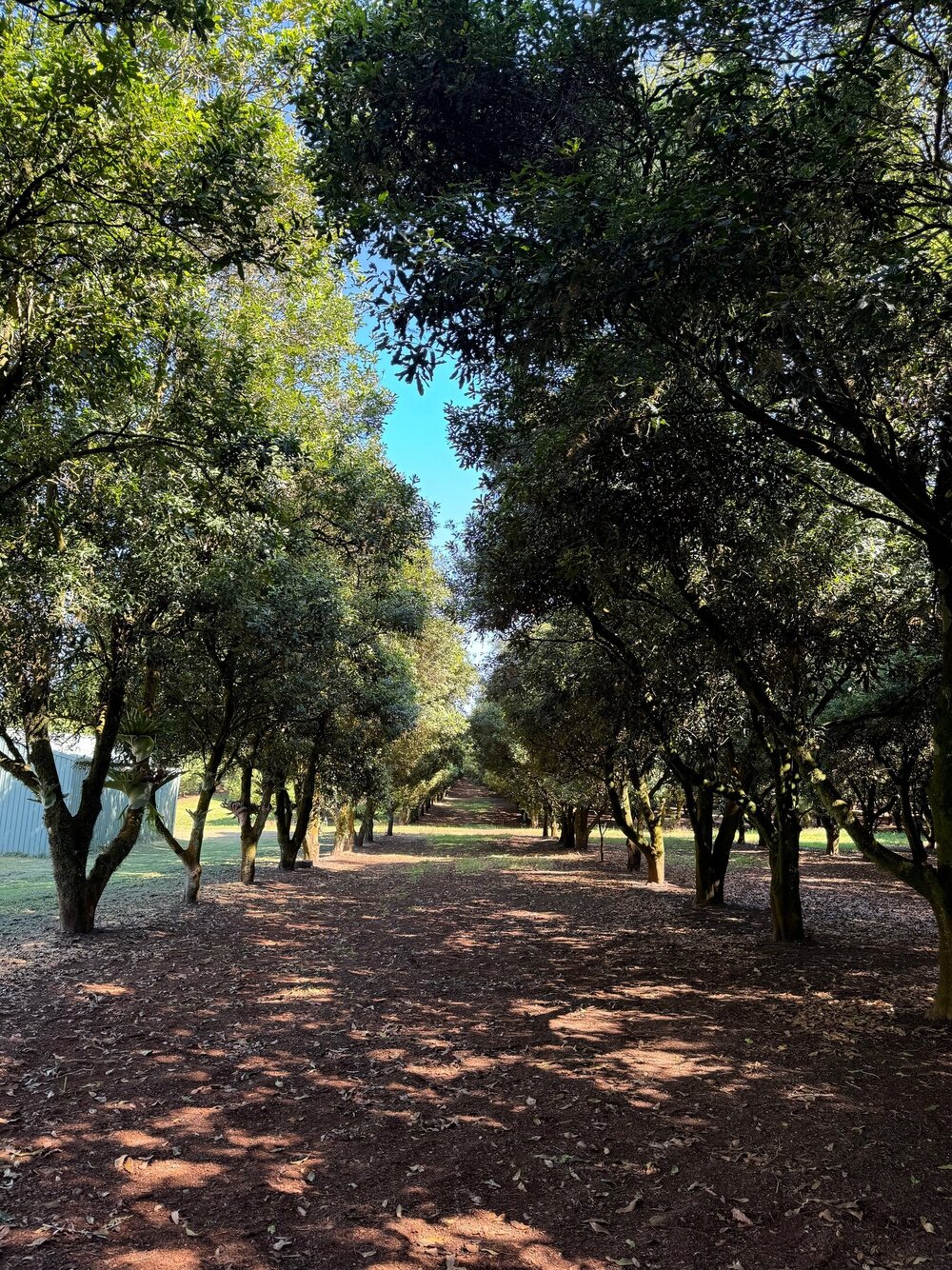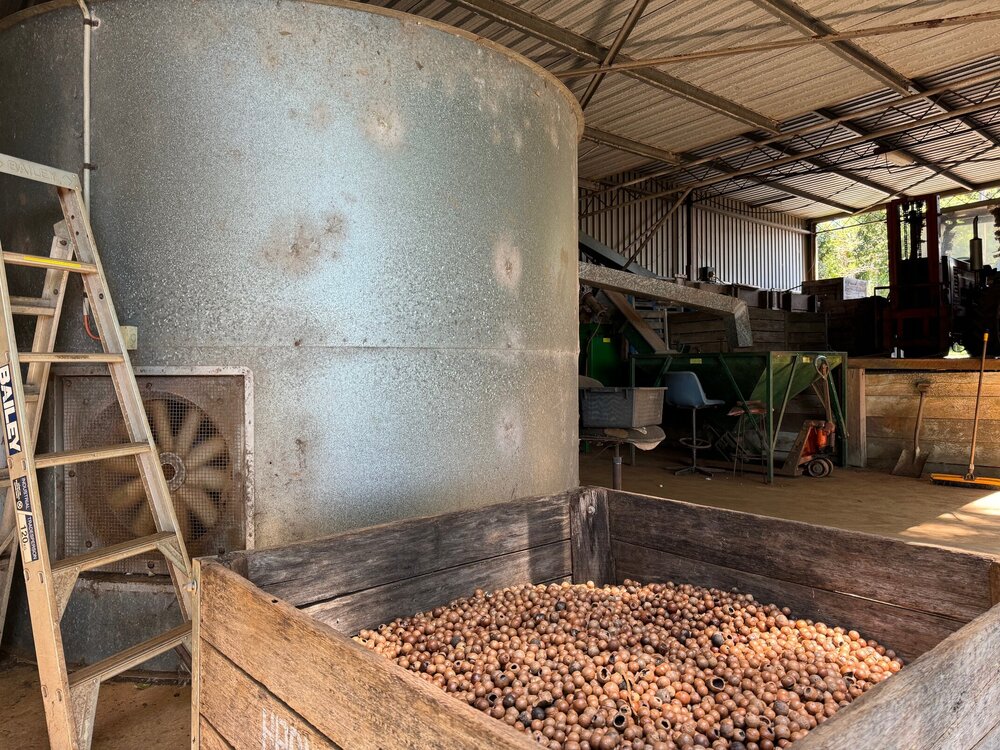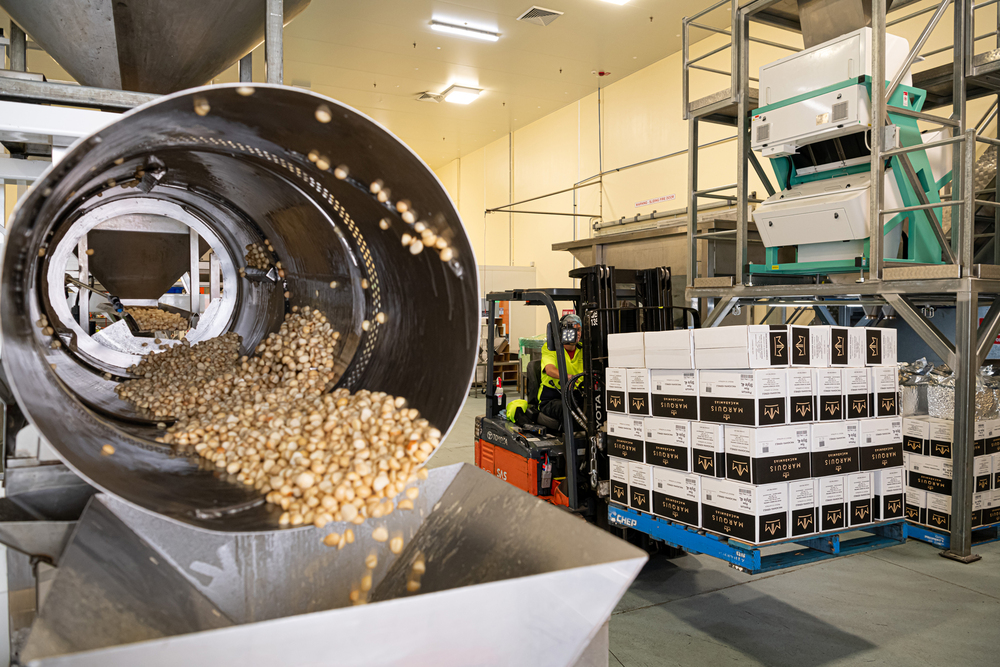NRs Macadamia Farms: Breakeven at best last few years
Simon Mumford
13 October 2024, 8:00 PM

The Northern Rivers macadamia industry is changing, not quickly, but noticeably. The industry has been a strong part of the Lismore and Northern Rivers agricultural history for over 50 years.
According to owners and managers, the general public's perception of operating a macadamia farm is that you plant a few thousand trees, wait until they fruit, pick them, and make loads of money. The truth is a long way from that perception.
This is Part II in our three-part series on whether the Northern Rivers macadamia industry will survive and, if so, in what form.
We talk to a former farmer, Peter Colby and Peter Cloutier; a current farm manager, Paul Mavis; a former Australian Macadamia Society Executive Officer and macadamia farm owner/grower Andrew Heap; and Australia's largest grower, marketer and processor, Marquis Macadamias.

(Paul Mavis managing his macadamia farm in Alstonville)
The bottom line is that if you want to make a living from growing macadamias, revenue needs to be more than the costs. After all, it is a business like any other.
In recent years, that scenario has not been the case for the small-scale macadamia farmers in the Northern Rivers. When we are talking small-scale, we are referring to those farms that are under 10,000 macadamia trees. In essence, these are the people who purchased a macadamia farm in the 1980s or 1990s when the industry was growing. Sydney-siders looking for tree change or investors looking to get into the burgeoning industry as well as looking for a beautiful area to take holidays.
Former Lismore City Councillor Peter Colby is one of the Sydney tree change population calling the Northern Rivers home. Peter purchased land around Clunes, which had about 2,500 macadamia trees.
"I saw the writing on the wall not long after I got into it. Basically, I saw that the costs were going through the roof, like labour. It was an old design plant. Half the trees were quite mature, and I just saw the writing on the wall that this wasn't a business that was sustainable for me because it needed continual investment to get it back to what it was, and 2,500 trees in 2025 will be unproductive.
One key problem for small macadamia farm owners is replacing the mature trees, 25 to 40 years old, with new trees. Older trees still produce nuts, but the yield is lower each year, while new trees take 2-3 years to produce their first crop. This has improved from 10 years ago when seven years was the timeframe before the tree would bear fruit. Then, every year after that, each tree will triple or quadruple its crop until maturity. The timeframe between crops leaves the grower with less annual harvest, leading to less revenue while costs continue to increase.
"I sold the whole lot as a going concern. I looked at it differently. I wasn't emotionally attached to the macadamia farm, and I found it after coming from the corporate world; sitting on a tractor for a day and not talking to anybody wasn't my world.
"When you look at the business model, I could see the issues and the challenges ahead. I'm surprised that, in some respects, there wasn't a lot more energy put into helping farmers overcome their next hurdles, which were the actual productivity and costs of harvesting macadamia nuts. And then you start to think about all the issues relating to the pests and the chemicals that you've got to use and all those sorts of things. Bugs become more resilient to chemicals, and there's a whole different flavour coming to the game."
Paul Mavis manages a macadamia farm at Alstonville and has done so for the last forty years.
Paul's farm is 90 acres with 6,000 macadamia trees. It was purchased by a Sydney family in 1979 and has since been handed down to the owner's children. They travel north, spend time on the farm, have meetings, a holiday at times and fly home. According to Paul, they will never sell, even if the land is worth $3-4 million.
"I've got blocks out there that have four-year-old trees on them because the old ones weren't producing anymore. They were one of the first blocks that we planted."

Paul has now prepared a patch on the property to graft and grow the next generation of macadamia trees so they can reach that two to three-year nut-producing age before replacing older trees with declining yields. This is Paul's way of managing the vital transitional period to keep the annual tonnage as high as possible in the future.
For former Australian Macadamia Society (AMS) Executive Officer and macadamia farmer, Andrew Heap, the process and choices are more difficult because his farm is much smaller.
Andrew and his wife Jacqueline purchased their farm in 2000. Working for the AMS, Andrew felt he would have a much deeper understanding of the industry if he became a grower. While that part was certainly true, Andrew is now finding that working a small macadamia farm is all-consuming because keeping the costs low means doing the majority of your work yourself, with labour costs so high.
"I've proved to myself that you can do it on a small farm. I had some very good teachers early on and was in the fortunate position of being able to see what was happening in the industry. So many others who come into the industry don't have that benefit. But I proved to myself that you can be viable on a small farm, provided you prepared to do the work."
That work often involves 10-12 hour days, six to seven days a week during peak times. The Northern Rivers has the highest rainfall area in NSW, and as we know, we have experienced an increase in intense rainfall, which makes farming even more difficult, especially if you have steep topography as part of your property.
"It can get really, really tough. We've had these 300 mil raindrops over two or three or four days. That plays havoc with the farm and managing nutrition, picking up limbs that fall off, particularly from taller trees, although small trees can be blown over as well."

(A bin of macadamia reject nuts at Andrew Heap's property in Wollongbar)
Small macadamia farm owners are now asking themselves the question, "Should I get a full-time job and pay someone to manage my farm, or should I go full-time into farm management myself? Will I make enough money?"
"Not on a smaller farm. You can't do that, particularly as wages have pushed ahead. And then we're a high-cost country. We are a regulated country. It's one of the reasons I try and do it myself because I have great uncertainties about employing labour that you are accountable for. The premiums you're going to pay on insurance are going to be higher, one way or another. But, there's also a degree of satisfaction from doing yourself too."
Marquis Macadamias is one of Australia's largest growers and processors of Macadamia nuts. Ben Adams is the CEO.
Ben agrees that many macadamia orchards in the Northern Rivers are small and challenging to manage. Lismore's 2023 receivals was significantly lower than the previous year at 7,825 tonnes of NIS, which was eclipsed by Bundaberg for the first time, which received 11,139 tonnes of NIS.

(Marquis Macadamias processing plant in Lindendale. Photo: supplied)
"The devastating floods of 2022 and 2023, combined with the reduced notional price, led some growers to remove trees and transition out of macadamias or replace them with updated varieties. However, there’s good news for the current season: prices have improved, and Lismore has already reached 8,800 tonnes. Our Grower Services Team is doing an excellent job supporting small farmers by implementing best farming practices to boost productivity."
But the question remains: will best practice be enough to make small orchards profitable enough for people to make a living?
REVENUE VERSUS COSTS
All macadamia owners or managers agree that the yearly revenue cannot be controlled. They have to accept what comes their way from whichever processor they sell their nuts in shell to. Processors have to think about how much of their crop they can sell to the Australian and global markets. The global markets buy 90% of the Australian harvest each year.
As we mentioned in Part 1, 2020 secured the highest price in its history of $6 per kilo at 33% premium kernel recovery and 10% nut-in-shell moisture content. That dropped to $1.70 in 2023, and Marquis has said the notional price for 2024 will be $3.20 p/kg, with some growers achieving a higher price if the quality of their harvest is higher than the 33% kernel recovery.
Cost is the one component that is in the grower's control. Labour, spraying, fuel, fertilising, hedging, pest control, electricity 24 hours a day running fans, replacing trees, replacing tractors or harvesters
Paul Mavis said it is costing a lot more to run the farms now than it did five or six years ago.
"It's all our fuel, fertiliser, contractors and such that have gone up, but our price of nut has gone up much."
"The last couple of years, we have lost money. That is all farms. I don't think anyone made any money. I know people that were pulling them (trees) out."
"We've got to cut down on our costs, which we've had to do the last two years. The main ingredients we need, like fertiliser, because you've got to feed them, so that's done regardless, and spraying your trees has to be done, we keep doing. But your pruning and selective limb removal can wait."
Selective pruning and limb removal allow sunlight to reach more limbs of a macadamia tree between rows. Like a rainforest, the limbs crossover, blocking the sunlight, thus reducing the tree's capacity to produce a maximum yield.
Pests and disease are another important part of a farm cost base that maximises the harvest.

(Diseased and a perfect macadamia nut in shell)
Regular spraying to keep out pests like borers is a must. The height of a tree can affect the effectiveness of the spray. Some 40-year-old macadamia trees are taller than what small spray machinery can reach.
If the ground cover between rows and around the trees is not kept low and tidy, rats can cause a 10% loss of a harvest, especially if they are the thinner shell variety that can generate a higher kernel percentage.
Andrew Heap says rats can eat through a nutshell in less than a minute. "Rats are a major issue, a major issue. There was quite a lot of research 20 years ago that shows that unless you manage the rat problem fairly carefully, you can lose anything up to 10% of your crop if it's dirty. They get into them very quickly. Less than a minute, we're talking seconds if they're angry."
"They will build up over time. The thing that's interesting is that rats get educated. So, you need to have a gap in the feeding regime so that the next generation don't learn from their parents."
The above scenarios are examples of regular operating costs and show how the cost base per unit has continued to rise. That is not taking into account the capital-intensive costs of tractors, harvesters, dehuskers and storage silos. As an example, a brand new Robmac harvester will cost more than $72,000.
Breaking Even
Macadamia growers get an indication of the size of a crop each year around December to early January. Harvesting starts in March and runs until September in the Northern Rivers.
As everyone knows about farming, climate can influence what sort of harvest year it is going to be. It is the one aspect, like selling prices, that is completely out of their hands.
To make money, in Lismore and the Northern Rivers, you have to get your tonnage up.
"If you can get your tonnage up, your $3.50 is still going to make you money," Paul Mavis said.
"I tell the owners we might get maybe 70 to 80 tonnes if it goes all right," Paul Mavis said, "So if we didn't get this wet weather this year that we got early, we would have got over 100 tonnes here."
The average tonnage for Paul's orchard is around 80 tonne; this year, the harvest was 92 tonnes. In 2023, the harvest was only 50 tonnes, and the year before that was 60 tonnes. If you have a low tonnage and low prices, it is very easy to see how you can lose money.
The topography in Lismore and the Northern Rivers makes managing a macadamia orchard difficult. North in Bundaberg, there are long, flat rows of trees that can be sprayed or fertilised easily. In contrast, we have steep slopes that were initially planned to be hand-harvested. There are times when the ground is so wet and steep that a tractor or harvester cannot get access to that part of the property, which leads to disease and loss of produce.
"If dealing with intense weather events isn't enough, when the cost of production is increasingly set by newcomers to the area, it calls for greater flexibility in land use because most serious farmers do not have a paid job to cover shortfalls", Andrew Heap said.

(Andrew Heap's macadamia harvester)
The chance of turning a profit can rely on the number of higher-quality nuts in shell. The price per kilo is based on 33% kernel recovery, but if that percentage increases to 34% or 35%, then the grower will receive a higher price for their crop.
One of the newer varieties of macadamia trees has a thinner shell, so it has a larger kernel. One key is to have the right balance of thin-shell varieties and solid, reliable grafting trees with thicker shells.
In recent years, the combination of wet weather and low prices has seen macadamia farms in Lismore and the Northern Rivers lose money or break even at best. Let alone make enough money to earn a living or re-invest money back into the farm and hoping for a better harvest the following year.
In Part III of the Northern Rivers Macadamia Industry, we will ask our experts to gaze into the crystal ball and predict the future of macadamia farms in our region.

